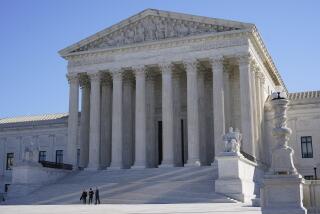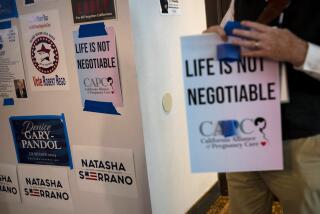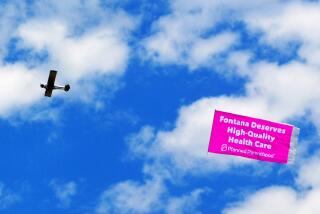Justices Allow Curbs on Anti-Abortion Protests : Law: High court refuses to hear challenge to N.J. order banning most picketing near doctorâs home. Scalia objects.
WASHINGTON â The Supreme Court, over the strong objection of Justice Antonin Scalia, on Tuesday let stand a New Jersey court order that bans virtually all peaceful picketing near the home of a doctor who performs abortions.
The justices refused to hear the claim that such a broad ban on picketing violates the free-speech rights guaranteed by the First Amendment.
Even though the abortion protesters were not accused of being loud, disruptive or violent, the New Jersey Supreme Court said they may march for only one hour every other week and may come no closer than 100 feet to the home of Dr. Elrick Murray in Westfield, N.J., a suburb of New York City.
The outcome in the New Jersey case is consistent with a series of recent state court rulings, including one last week in California, that have barred protesters from marching or carrying signs near the homes of abortion doctors. Earlier this month, the Los Angeles City Council passed a new law that makes it a crime to picket within 100 feet of a particular home or dwelling in the city.
âThis is extremely important because it provides some measure of privacy to these physicians in their own homes. They are under siege everywhere else,â said Dara Klassel, a Planned Parenthood Federation attorney who represented Murray.
But Scalia, who is both a strong conservative and zealous advocate of free speech, accused his colleagues of treating abortion protesters as a âcurrently disfavored class.â
In the past, picketing and marching by civil rights protesters, union members or political activists has been protected as a form of free expression, Scalia noted, so long as the marchers did not block the sidewalks or disturb the peace.
The high courtâs willingness to allow restraints on abortion protesters âhas damaged the First Amendment more quickly and more severely than I feared,â Scalia wrote in the case (Lawson vs. Murray, 94-1450).
He referred in particular to a split decision last June in which the high court upheld a âbuffer-zoneâ around an embattled Florida abortion clinic while also striking down a judgeâs order that put a 300-foot, no-picketing zone around the homes of clinic workers.
In a seemingly off-hand comment in the case of Madsen vs. Womenâs Health Center, Chief Justice William H. Rehnquist added that âa smaller [no-picketing] zoneâ might be constitutional in residential neighborhoods.
Since then, state courts in North Carolina, Ohio and California have seized on Rehnquistâs comment and upheld broad ordinances or court orders banning picketing in residential areas, say lawyers who have followed the issue.
âThereâs a double standard here,â said Richard F. Collier Jr., a New Jersey attorney representing the abortion protesters. âThe First Amendment rights of pro-lifers are treated differently than the rights of any class of protesters. If this involved gay rights or animal rights or civil rights, I think they [the justices] would have taken this case.â
The issue of picketing outside the homes of abortion doctors has divided traditional allies on both the left and right.
The American Civil Liberties Union joined the New Jersey case on the side of the abortion protesters.
âWe essentially agree with Justice Scalia. This was a peaceful demonstration in a residential zone, and it did not interfere with a womanâs right to choose,â said Marsha Wenk, legal director for the ACLU in Newark, N.J.
Last year, Rehnquist wrote the courtâs opinion restricting the free-speech rights of abortion protesters and he was joined wholeheartedly by retiring Justice Harry A. Blackmun, the author of the 1973 Roe vs. Wade decision that ensured the right of women to seek abortions.
It is not the first time that Scalia and Rehnquist have parted company on free-speech matters. In 1989, Scalia cast a decisive vote to rule that burning a flag was protected as free expression, while Rehnquist strongly dissented.
The issue of residential picketing is almost certain to return to the high court.
Seven years ago, the justices upheld a Wisconsin cityâs law that barred picketers from gathering directly in front of doctorâs home, but the case of Frisby vs. Schultz did not spell out how far they could be kept away.
A 1993 San Jose ordinance bans picketing within 300 feet of a residence. Last week, the California Supreme Court refused to hear a free-speech challenge to the law.
âMy 16 clients were arrested for peacefully carrying signs around the block,â said Michael Millen, an attorney who is representing the anti-abortion protesters in San Jose. âUnder this law, you can be banned from carrying a sign in front of the mayorâs house.â
Three weeks ago, the Los Angeles council passed a new measure to shield abortion clinics from disruptive protesters. The police were given the authority to keep demonstrators 50 feet away from a clinic if they âviolate [its] peace or security.â
Separately, the ordinance makes âtargeted demonstrations focused upon and at or about a private residenceâ illegal.
In other actions, the high court:
* Gave some disgruntled workers more time to file lawsuits if they contend that their employers failed to give them the required notice before a layoff. In a 9-0 ruling (North Star Steel vs. Thomas, 94-834), the court said generally more lenient state deadlines, rather than the six-month federal deadline, should apply in such situations.
* Made it easier for inmates who are serving multiple sentences to appeal their cases in federal courts. They are still âin custodyâ and can challenge their convictions, the court said in the case (Garlotte vs. Fordice, 94-6790), even if they have served their sentences for the convictions they are actually contesting.
More to Read
Get the L.A. Times Politics newsletter
Deeply reported insights into legislation, politics and policy from Sacramento, Washington and beyond. In your inbox three times per week.
You may occasionally receive promotional content from the Los Angeles Times.











